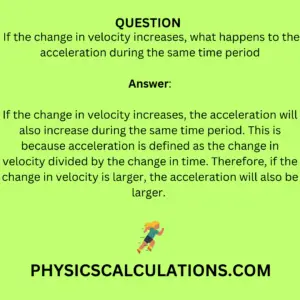Question
If the change in velocity increases, what happens to the acceleration during the same time period.
Answer
If the change in velocity increases, the acceleration will also increase during the same time period. This is because acceleration is defined as the change in velocity divided by the change in time. Therefore, if the change in velocity is larger, the acceleration will also be larger.

For example, if an object’s velocity changes from 10 m/s to 20 m/s in 1 second, the acceleration is 10 m/s-2. If the object’s velocity changes from 10 m/s to 30 m/s in 1 second, the acceleration is 20 m/s-2. In both cases, the change in time is 1 second, but the change in velocity is larger in the second case, so the acceleration is also larger.
It is important to note that acceleration can be positive or negative. A positive acceleration means that the velocity is increasing, while a negative acceleration means that the velocity is decreasing. So, if the change in velocity is negative, the acceleration will also be negative.
Explanation
Acceleration is the rate at which an object’s velocity changes over time. It is calculated by dividing the change in velocity by the change in time. Mathematically, acceleration (a) can be expressed as:
a = Δv / Δt
Where Δv represents the change in velocity and Δt represents the change in time.
When the change in velocity increases, it means that the object’s velocity is changing at a faster rate. If we consider a positive change in velocity, it indicates that the object is speeding up or moving in a positive direction. In this case, if the change in velocity becomes larger, the acceleration will also increase during the same time period.
To illustrate this, let us take an example. Suppose an object’s velocity changes from 30 m/s to 40 m/s in 2 seconds. Here, the change in velocity (Δv) is 10 m/s, and the change in time (Δt) is 2 seconds. Dividing the change in velocity by the change in time, we find that the acceleration is 5 m/s2.
Now, consider another scenario where the object’s velocity changes from 50 m/s to 70 m/s in 4 seconds. In this case, the change in velocity (Δv) is 20 m/s, while the change in time (Δt) remains 4 seconds. Dividing the change in velocity by the change in time, we obtain an acceleration of 5 m/s2. As the change in velocity is larger, the acceleration also increases.
Acceleration can be positive or negative, depending on the direction of the change in velocity. A positive acceleration signifies an increase in velocity, while a negative acceleration represents a decrease in velocity.
Conclusion
If an object’s initial velocity is 30 m/s and it slows down to 20 m/s in 2 seconds, the change in velocity (Δv) is -10 m/s (negative because velocity decreases), and the change in time (Δt) is 2 seconds. Dividing -10 m/s by 2 seconds, we find a negative acceleration of -5 m/s^2. In this case, the object is decelerating or experiencing negative acceleration.
To summarize, when the change in velocity increases, the acceleration will also increase during the same time period. A positive change in velocity results in a positive acceleration, indicating an increase in speed, while a negative change in velocity leads to a negative acceleration, representing a decrease in speed or deceleration.
You may also like to read:
A long distance runner is running at a constant speed of 5 m/s.